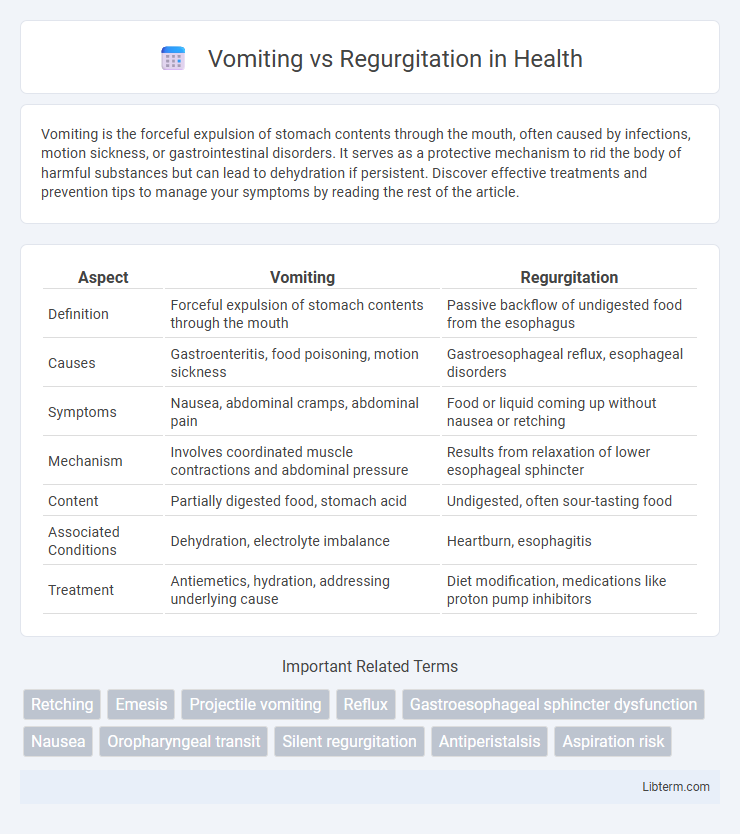Vomiting is the forceful expulsion of stomach contents through the mouth, often caused by infections, motion sickness, or gastrointestinal disorders. It serves as a protective mechanism to rid the body of harmful substances but can lead to dehydration if persistent. Discover effective treatments and prevention tips to manage your symptoms by reading the rest of the article.
Table of Comparison
| Aspect | Vomiting | Regurgitation |
|---|---|---|
| Definition | Forceful expulsion of stomach contents through the mouth | Passive backflow of undigested food from the esophagus |
| Causes | Gastroenteritis, food poisoning, motion sickness | Gastroesophageal reflux, esophageal disorders |
| Symptoms | Nausea, abdominal cramps, abdominal pain | Food or liquid coming up without nausea or retching |
| Mechanism | Involves coordinated muscle contractions and abdominal pressure | Results from relaxation of lower esophageal sphincter |
| Content | Partially digested food, stomach acid | Undigested, often sour-tasting food |
| Associated Conditions | Dehydration, electrolyte imbalance | Heartburn, esophagitis |
| Treatment | Antiemetics, hydration, addressing underlying cause | Diet modification, medications like proton pump inhibitors |
Introduction to Vomiting and Regurgitation
Vomiting is the forceful expulsion of stomach contents through the mouth, often accompanied by nausea and abdominal muscle contractions, indicating a complex reflex involving the central nervous system and gastrointestinal tract. Regurgitation is the passive, effortless return of undigested food or liquid from the esophagus or stomach into the mouth without nausea or retching, commonly observed in conditions affecting the esophageal sphincter or motility. Differentiating vomiting from regurgitation is essential for accurate diagnosis and treatment of underlying gastrointestinal disorders.
Defining Vomiting: Causes and Mechanisms
Vomiting is the forceful expulsion of stomach contents through the mouth, triggered by complex neural pathways involving the vomiting center in the brainstem. Common causes include gastrointestinal infections, motion sickness, pregnancy, medication side effects, and central nervous system disorders. The mechanism involves coordinated contraction of abdominal muscles, diaphragm, and relaxation of the lower esophageal sphincter to propel gastric contents outward.
Understanding Regurgitation: Key Characteristics
Regurgitation involves the passive return of undigested food from the esophagus or stomach without nausea or abdominal contractions, distinguishing it from vomiting. It typically occurs shortly after eating, with the expelled material appearing as a painless, effortless flow. Recognizing these characteristics aids in diagnosing underlying conditions such as esophageal disorders or anatomical abnormalities.
Main Differences Between Vomiting and Regurgitation
Vomiting involves forceful expulsion of stomach contents through the mouth, triggered by nausea and usually accompanied by retching, whereas regurgitation is the passive backup of undigested food from the esophagus without nausea or abdominal contractions. Vomiting is controlled by the brain's vomiting center and often signals gastrointestinal disturbances, while regurgitation results from esophageal dysfunction or disorders like gastroesophageal reflux disease (GERD). Understanding these key distinctions aids in accurate diagnosis and appropriate treatment for conditions presenting with oral expulsion of stomach or esophageal contents.
Common Causes of Vomiting
Vomiting is the forceful expulsion of stomach contents through the mouth caused by triggers such as gastrointestinal infections, food poisoning, migraines, motion sickness, and pregnancy. Common causes include viral gastroenteritis, medication side effects, and metabolic disorders like diabetic ketoacidosis. Regurgitation, in contrast, is a passive, effortless return of undigested food from the esophagus without nausea or retching.
Common Triggers for Regurgitation
Regurgitation is commonly triggered by factors such as gastroesophageal reflux disease (GERD), esophageal motility disorders, and delayed gastric emptying, leading to the backflow of undigested food without nausea or forceful abdominal contractions. Other frequent causes include anatomical abnormalities like hiatal hernia and esophageal strictures that impair proper food passage. Understanding these triggers is vital for differentiating regurgitation from vomiting, which involves forceful expulsion and is often accompanied by nausea.
Symptoms Associated with Vomiting
Vomiting is characterized by forceful expulsion of stomach contents, often accompanied by nausea, abdominal pain, and sweating. Symptoms associated with vomiting include dehydration, electrolyte imbalance, and abdominal cramping. In contrast, regurgitation involves passive backflow of undigested food without the nausea or forceful muscle contractions seen in vomiting.
Signs and Manifestations of Regurgitation
Regurgitation is characterized by the effortless backflow of undigested food or liquid from the esophagus into the mouth without nausea or abdominal contractions, distinguishing it from vomiting. Common signs include the passive expulsion of material shortly after eating, often described as a gentle reflux or spitting up, especially in infants and patients with esophageal motility disorders. Unlike vomiting, regurgitation lacks preceding retching and is usually non-projectile, with the expelled content typically being sour-tasting due to acid reflux.
Diagnosis: How to Distinguish Vomiting from Regurgitation
Vomiting is characterized by a forceful expulsion of stomach contents through the mouth, often preceded by nausea and retching, while regurgitation involves the passive backflow of undigested food from the esophagus without retching or nausea. Diagnostic differentiation relies on clinical history, where vomiting presents with abdominal contractions and a prodromal phase, whereas regurgitation occurs immediately after eating with minimal effort. Observing the expelled material's appearance--vomitus is typically acidic and contains bile, whereas regurgitated food is more neutral and undigested--also aids in accurate diagnosis.
Treatment and Management Approaches
Treatment for vomiting involves addressing the underlying cause, such as infections, gastrointestinal disorders, or toxins, using antiemetics like ondansetron or metoclopramide to control nausea and prevent dehydration with fluid replacement therapy. In contrast, managing regurgitation primarily focuses on lifestyle modifications and dietary changes, such as smaller, frequent meals and avoiding trigger foods, along with anatomical interventions like fundoplication in severe cases of gastroesophageal reflux. Both conditions require careful monitoring to prevent complications, but vomiting often necessitates more aggressive medical intervention due to its potential impact on electrolyte balance and hydration status.
Vomiting Infographic

 libterm.com
libterm.com